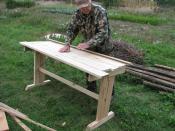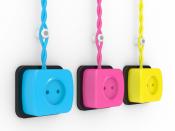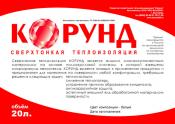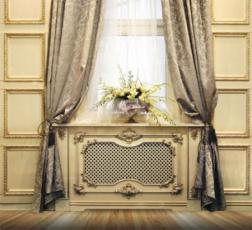Search
Login
Screens on a heating radiator, how to choose, how to install correctly
Agree, heating radiators, even if they have a modern design, not a single designer will call a detail working to create an attractive interior. Moreover, if the owners of the house are not supporters of innovations and give preference to the proven old version - cast iron radiators. Since the best place to install heating devices in the room is a niche under the window, i.e. one of the most noticeable places in the room, the question of how to hide the heating batteries, while ensuring maximum heat transfer from them, becomes quite relevant.
Content:
- Decorative screens for radiators and materials for their manufacture video
- Recommendations for choosing a screen design for radiators
- How to install decorative screensvideo
- How to make a screen for a heating radiator with your own hands video
Decorative screens for radiators and materials for their manufacture
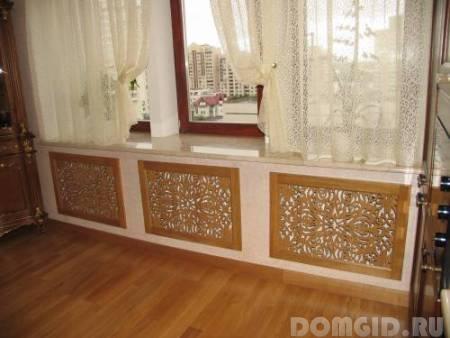
Decorative screens for radiators carry not only an aesthetic load, but also serve as a means of protection against injuries, especially for rooms designed for children’s games and sports. In an apartment or house, they are more likely to be used for decorative purposes, however, they can prevent the onset of a burn in a small child who accidentally touches them.
In addition, decorative screens work to increase the heat transfer of heating appliances. Shielding bulky batteries from the view, the screens give the room an elegant and complete look.
If we talk about the design, the screens can be:
- mounted, box-shaped and covering the heater on all sides,
- flat, covering only the front of the battery,
- without cover or with cover.
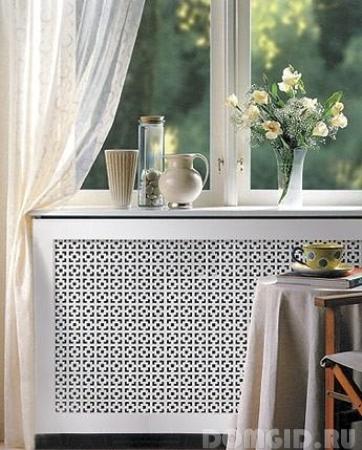
Screens can be made of:
- metal or glass
- plastic, HDF or MDF,
- natural wood.
metal screens
Metal structures began to be used more than a century ago; for their manufacture, a metal sheet painted by the powder method is used. The cost of such a product is low and justifies its rather primitive appearance. More expensive and attractive models of screens are made of stainless steel, for the decoration of which an intricate perforated pattern is used.
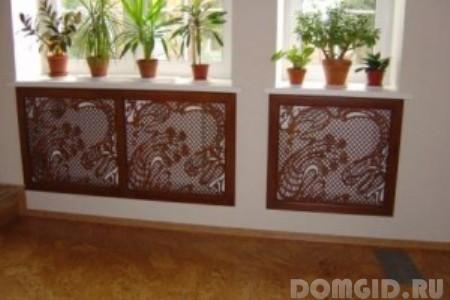
A positive property of metal decorative screens are:
- high heat dissipation,
- ease of maintenance, to clean the surface you just need to rinse it under running water,
- reliable protection of a radiator against dust and pollution,
- simplicity of installation and dismantle,
- ability to maintain color and shape during operation.
The metal screen for the battery will look best in an interior decorated in the style of Hi tech or Techno.
wood models
Wood grillesfor decor of heating radiators can be attributed to the classic version, wood material is characterized by not very high heat dissipation, therefore, wooden grilles on heating radiators should be made in accordance with the recommendations of engineers, the material for their manufacture can be used in a wide variety. The use of valuable wood and a variety of modern paints and varnishes allows you to turn the lattice into a real work of art, worthy to decorate a rather refined interior.
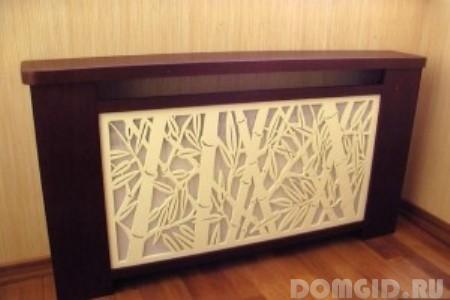
When ordering a grill, it is possible to choose a material and design option suitable for the general style of the room.
The most stylish wood material today is rattan(dried and peeled in a certain way stalks of Calamus creeper, characterized by a three-layer structure). In the process of steam processing, the stems become elastic, which allows them to give them an original shape. Further, in the drying process, the material acquires rigidity and very high resistance to deforming loads.
One of its important advantages is its environmental friendliness. In addition, rattan screens:
- have a highly aesthetic appearance
- able to decorate the interior, go well with other furnishings made of wood,
- provide relatively good heat dissipation,
- easy to install.
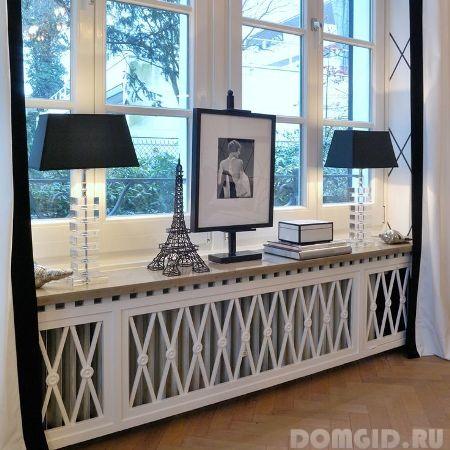
Common disadvantages of wood screens include:
- pretty high cost
- tendency to change geometric parameters,
- the need for quality care using special products.
glass screens
For their manufacture use stained glass 8 mm thick. Glass models are used in interiors decorated with special sophistication and serve as an exclusive element of decor, emphasizing the elegance of design. The glass used in their manufacture is laminated; it is practically impossible to break it. Glass surface can be cleaned with any detergent.
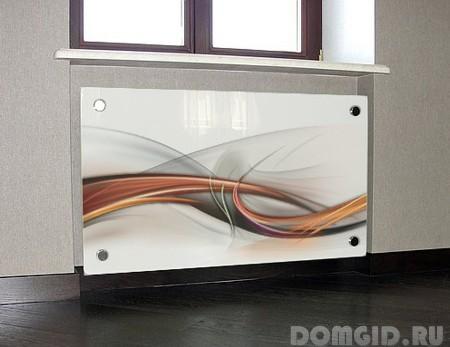
A more budgetary option is acrylic glass, it has a greater thickness, but its specific gravity is lower. An attractive point is the ability to choose a shade from a fairly wide range of colors.
Designers do not refuse to use such a variety of modern material as triplex, which is a laminated glass connected by a polymer composition.

Since glass is a material suitable for the use of photo printing, a variety of drawings are often applied to improve its surface, matching the theme of the design of the room.
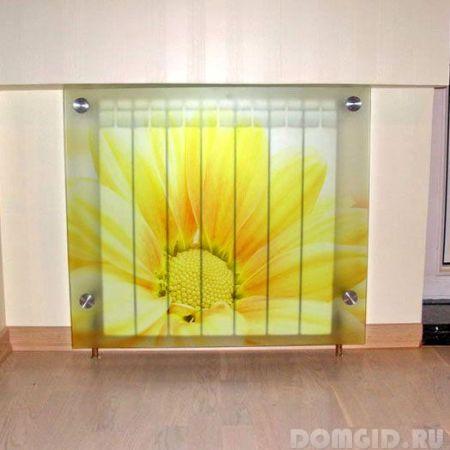
Also often used is hand-painted stained glass windows-screens with silicate paints, followed by firing in an oven.
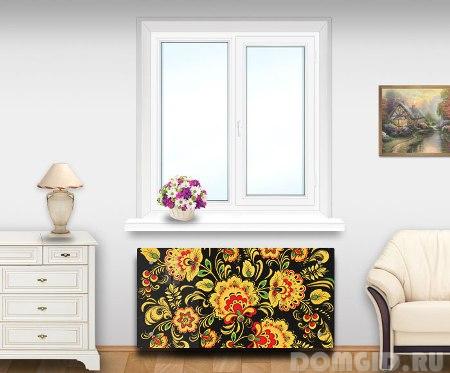
In the manufacture of screens for radiators, other, more complex, techniques for performing stained-glass windows can also be used:
- fusing
- Tiffany
- molded
- facet,
- film
- filler.
Among the advantages of glass screens should be remembered:
- high esthetics,
- security,
- preservation of the decorative appearance over a long period of operation,
- the ability to create custom-made unique models specifically for your interior.
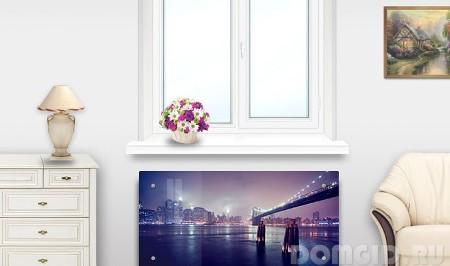
Disadvantages:
- the need for a more careful attitude in the operation and removal of pollution, the creation of an obstacle to the movement of thermal air masses,
- pretty high cost.
budget option - a plastic decorative panel for the radiator
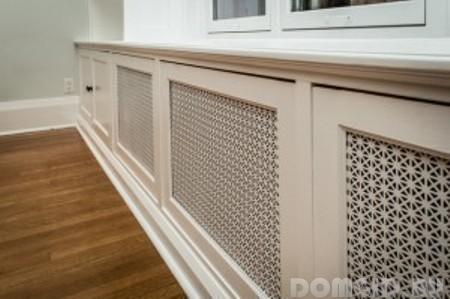
Today, plastic is a widespread material; its use in everyday life often determines the cheapness of plastic products. But it is impossible to forget that certain factors can cause the release of toxic substances from this material. In addition, at high temperatures, the plastic surface tends to change its geometry. Plastic decorative panels for radiators are not particularly distinguished by a variety of shades.
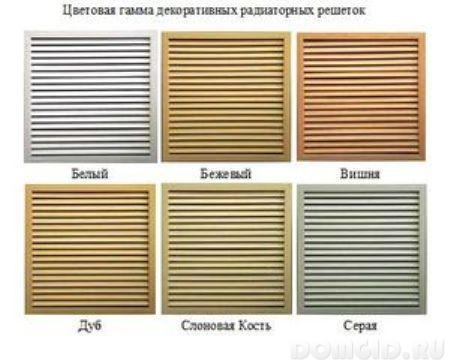
Among the advantages of plastic products include:
- light weight
- low cost.
When choosing plastic models, it should be borne in mind that the panels will not last long, during operation it will be necessary to systematically ventilate the room in which they are installed.
hardboard box screens
Pressed materials, such as HDF and MDF, are often used to make boxes, but an insert made of wood or plastic materials should serve as a screen. It is not recommended to use a solid surface of the hardboard box with small holes: it will be a serious obstacle to normal heat transfer.
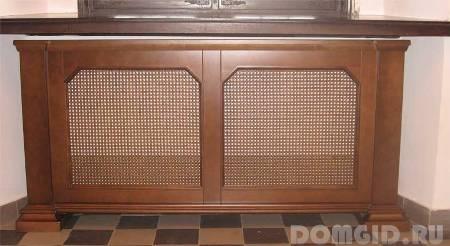
Hardboard boxes practically do not deform due to temperature, and insert-screens in them can be periodically changed. Since the structure is quite massive, it will be necessary to pay attention to the correctness of its installation - otherwise it can retain heat. outgoing from the battery. A certain difficulty will be caused by the process of cleaning the radiator itself from dust.
Recommendations for choosing a screen design for radiators

The design of the screen should be selected depending on how and where the radiators are located:
The batteries installed in the niche are conveniently hidden by flat structures or those that are superimposed on the batteries, in which case the recess is closed together with the radiators placed in it.
If the batteries are installed under the window sill and overlap it on top, then it will be enough to use pads without a cover, fasten them to the window sill.
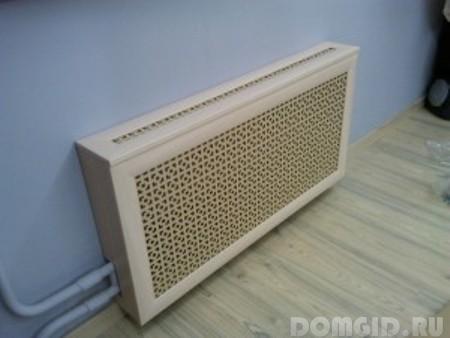
The batteries protruding beyond the surface of the windowsill will require the use of decorative covers with a cover.
If the heating devices are installed just near the wall, then the best thing is that they will be hidden by an extension box.
A well-chosen material will hide the batteries and become an attractive element that adorns the interior.
How to install decorative screens
Depending on the design of decorative panels, the option of their installation depends.
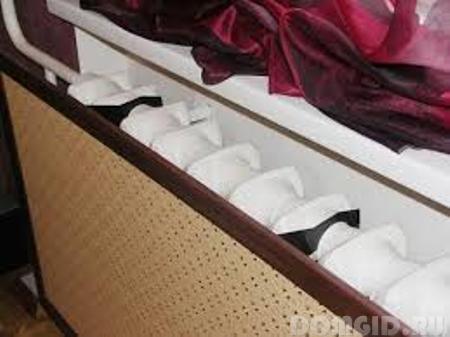
Hinged screens have a design that does not require any auxiliary mounting. They are hung on radiators, the curved shape of the upper part prevents them from sliding down. This option is especially convenient for small screen sizes, it will be just as easy to remove it as to install it.
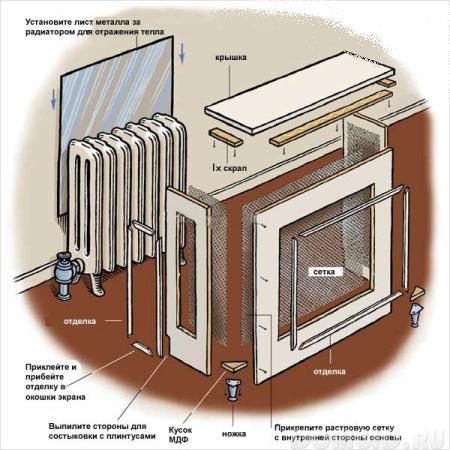
For screens in the form of a box, holes will be required to attach them to the wall. The task will be to transfer the attachment points to the wall and align them strictly horizontally. The easiest way to do this is by using a level. Further, holes are drilled at the marked points and fasteners are installed, a box will be hung on them.
If it is supposed to install the box on the floor, legs should be present in its design, the upper part of the box should be equipped with hooks placed on the sides - with their help the box will be attached to the radiator. This option is particularly popular with consumers due to the ease of installation design.
How to make a screen for a heating radiator with your own hands
Although there are a lot of materials from which screens are made, working with them is actually not very successful at home. For example, you should definitely abandon the idea of \u200b\u200bmaking a model from plastic. High-quality plastic has a relatively high cost, its thermal conductivity is far from ideal, at home it is not so easy to give a plastic product an attractive enough look, at least it will be more difficult than to process metal. In addition, it is possible that from exposure to high temperature the plastic will begin to lose shape and become stained.
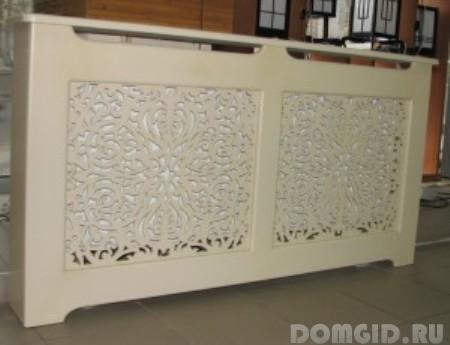
The cost of metal is quite affordable, such a material conducts heat fairly well. But working with metal requires certain skills; to get a decorative product, you will have to use professional tools.
Wood has an attractive appearance and is relatively easy to process, but its thermal conductivity does not allow screens to be blind, most often screens are made in the form of a lattice with large cells.
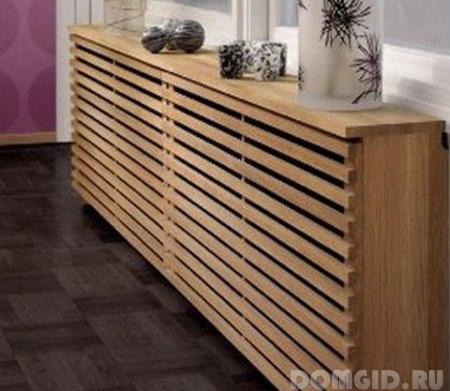
Wooden screens made according to the rules can be safely called quite effective.
How to make a beautiful lattice of wood, you can watch the video:
You can also come across recommendations for making a drywall screen. Although this material, like wood, has low thermal conductivity, calculations and practical studies show that with the correct execution of the screen and its installation, it is possible to increase the efficiency of heating radiators.
Drywall preparation will be as follows:
- sheet processing with a special needle roller for drywall,
- double impregnation of both sides of the sheet with an aqueous solution of PVA glue - this will significantly increase the thermal conductivity of the material, in addition, after such an impregnation, the drywall will not dry out, it will easily be evenly coated with paint.
It will be very easy to cut the processed sheets, and after processing with sandpaper and painting, the product will have a pretty decent appearance.
To obtain sufficient heat transfer, you will need to add some useful elements to the design you are creating:
- warm air injector
- aerodynamic visor.
To make them, you need tin, galvanized iron, in extreme cases, you can use cardboard, but you need to paste it with foil, you can use one that is used for baking products in the oven. It will be necessary to create a visor both for cast-iron radiators and for modern steel models. The absence of a visor will lead to the formation of an air cushion that can stop the convection process. The foil-coated visor will reflect some of the infrared radiation to the outside. If we take into account the duration of the heating period, then every minute the savings in a couple of kopecks as a result of the season will be a considerable amount.
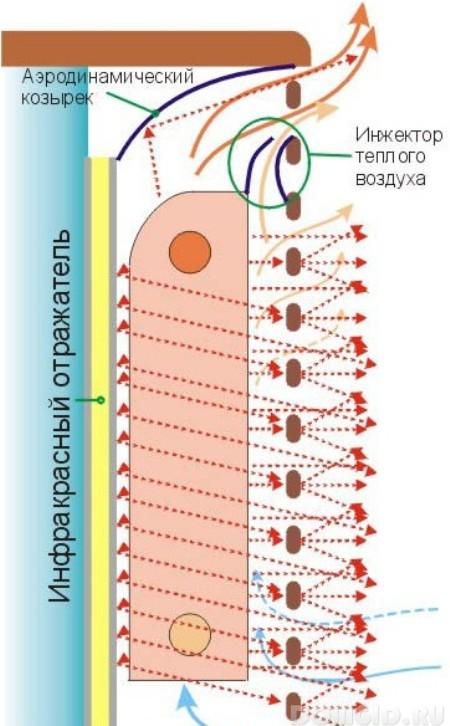
Installation of the injector will facilitate the intake of warm air from the front of the radiator. While the heaters are slightly heated, the injector practically does not work, but with an increase in their temperature, the draft will increase.
Another important event that it is desirable to perform is to install a reflective screen behind the battery, it is desirable that its surface is shiny, i.e. foil. But foil alone will not be enough, it is desirable to foil on both sides of a mat made of sintepon or other fibrous material. Calculations show that the infrared flux aimed at the wall will weaken by about forty times. Naturally, this will contribute to an even greater increase in the temperature of the radiator, and consequently to an increase in convection, which will result in an increase in temperature in the room.

